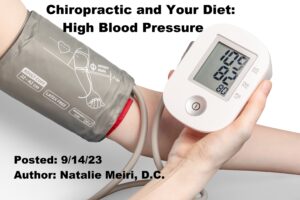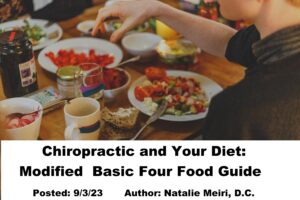
A Chiropractor in West Palm Beach can help you with many ailments by way of adjustments. However, the food you consume on a daily basis has a very large impact on your body and the thousands of underlying processes that go on inside it every day. Nutrition is certainly a significant factor in your health. So some of your lifestyle choices outside of the doctor’s office can influence the effectiveness of treatment. When you eat well, your immune system fights off illness better, you elevate your brain function, you lose weight and your energy soars. By incorporating certain foods into your diet, you can contribute to faster healing and continued wellness.
In this blog post, we’ll take a closer look at diet and nutritional changes, chiropractic care and improving your hypercholesterolemia (high cholesterol).
What is Hypercholesterolemia (high cholesterol)?
Ovewr 25% of adults in the USA have serum cholesterol levels over 200mg/dL High levels of a certain type of cholesterol is linked to heart disease and stroke. Cholesterol is a waxy substance made by your liver. It is used for important functions, such as making hormones, nervous system function and digesting fatty foods. However, too much cholesterol can cause plaques in blood vessels. Plaques can cause inflammation, rupture and cause clots, leading to a heart attack.
Some Facts about cholesterol
Ideal serum cholesterol values are below 200 mg/dl. Values above 240 mg/dl require further analysis by your primary care doctor. Coronary risk factors are: male gender, cigarette smoking, hypertension, severe obesity, diabetes, family history of premature (before age 55) coronary heart disease, diagnosed cardiovascular or peripheral vascular disease, low high density lipoprotein (HDL) cholesterol (below 35 mg/dl).

What can you do?
When dining out, avoid meat and cheese dishes, sauces, fried foods, and rich desserts. Furthermore, look for entrees with the specifications that it is inline with the American Heart Association guidelines. Seafood, salad entrees, and some ethnic cuisines (e.g. asian, middle eastern) are recommended.
Dietary Fiber
Soluble fiber lowers cholesterol by binding it to the small intestine. Once inside the small intestine, the fiber attaches to the cholesterol particles, preventing them from entering your bloodstream. So instead, cholesterol will exit the body through the feces.
Eat foods with high soluble fiber. For instance, oats, oatmeal, oat bran, whole fruits (apples) and legumes (beans, peas). Additionally, supplemental phyllium husk (10g/dl), pectin (6 to 50 g/d) or guar gum (5 to 30 g/d) may be added to meals.
Nutrient Deficiencies
Hypercholesterolemia (high cholesterol) can cause nutrient deficiencies. These include vitamin C, chromium or copper (especially if you are taking zinc).
Supplements
Taking fish oils may help if your triglycerides are elevated. Oils high in docosahexaenioic acid (DHA) and low in Eicosapentaenoic acid (EPA) may be best for reducing LDL and keeping HDL levels high. Calcium 2 g/d with meals may help bind your fats in the gastrointestinal tract. Also, garlic, 9 g/d fresh ( e.g. 3 cloves), 600 mg/d powder or 18 to 25 mg/d oil is helpful.
Lifestyle changes
Triglycerides are fats from the food we eat. Most of the fats we eat (e.g. butter) are in triglyceride form. So extra calories, alcohol and sugar in your body turn into triglycerides. Your body stores them in fat cells throughout your body.
High triglycerides (hypertriglyceridemia) can put you at a higher risk of heart and vascular (blood vessel) disease.
Weight management, restriction of alcohol (zero if hypertriglyceridemia), aerobic physical activity, simple sugar restriction, and eating fish several times a week are recommended.
High density Lipoprotein Deficiency
Cholesterol alone can’t mix with or dissolve in your blood. Instead, your liver packages cholesterol with triglycerides and proteins called lipoproteins. The lipoproteins move this fatty mixture to areas throughout your body. Moreover, the types of lipoproteins include: low density lipoproteins (LDL) and high density lipoproteins (HDL).
For adults, a normal triglyceride level is below 150 mg/dL. Your total cholesterol looks at a combination of triglycerides, HDL and LDL numbers. If your triglycerides and LDL cholesterol are high, but your HDL is low, you have an increased risk of heart attack and stroke.
What to do if you have low levels of High density lipoproteins (HDL)
You have low HDL if your HDL is below 35 mg/dl. You can do the following to correct this: Stop smoking, cut back on coffee, do moderate physical exercise, loose weight if necessary, use moderation with drinking alcohol, avoid sugar, garlic oil (18mg/d from three cloves) may help.
Olive oil reduces LDL and heart disease risk. Soybeans reduce LDL and triglycerides.
With all the above suggestions, please first check with your doctor who is managing your high cholesterol.

Chiropractic and Your Diet: High Cholesterol and Lipid Problems
According to the National Board of Chiropractic Examiners’ (Nabco’s) Practice Analysis of Chiropractic 2015 “Chiropractic is based on the premise that the body is able to achieve and maintain health through its own natural recuperative powers, provided it has a properly functioning nervous system and receives the necessary health maintenance components. These components include adequate nutrition, water, rest exercise and clean air”.
Your chiropractor in West Palm Beach will adjust your spine to improve the relationship between the spine and nervous system, which affects the function of all the organs and systems in your body. She will educate you on how to prevent future suffering by learning and implementing a lifestyle for health self enhancement. In this regard, we may give take home exercises, recommend ergonomic changes and nutritional changes. Call Dr. Natalie Meiri, your chiropractor in West Palm Beach at 561-253-8984 to find out more about Chiropractic and Your Diet: High Cholesterol and Lipid Problems or to schedule an appointment.



